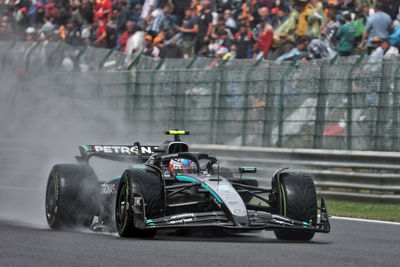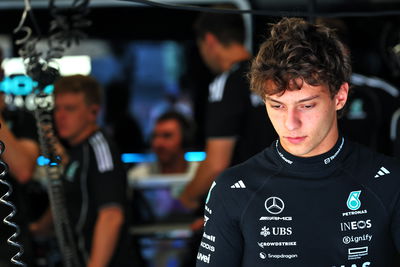Twelve months ago, Kimi Antoneri already knew she was making her Formula One debut with Mercedes this season.
Following a TPC (previous car test) outing after the Belgian Grand Prix, Antonelli was informed by Mercedes that he would replace seven-time world champion Lewis Hamilton and step into the Silver Arrows hot seat.
The move was not publicly announced at the Italian Grand Prix nearly a month later. There, Antonelli crashed on Mercedes’ practice debut.
However, preparations for life as a full-time Formula 1 driver have already begun, with Antonelli running several tests on Mercedes’ 2021 and 2022 cars in the Red Bull Rings in Austria and Imora.
The 17-year-old at the time was only midway through his Maiden Formula 2 campaign, during a rapid rise in the motorsport ranks where he bypassed Formula 3 after winning Italian F4 and ADAC F4 titles.
Combining Mercedes’ TPC program, FP1 sessions and postseason testing, Antonelli won about 9,000 kilometres behind the wheels of an F1 car before making his debut at the Australian Grand Prix.
“From a pure speed perspective, I don’t think that has changed,” Antonelli told Crash.Net and the racers only about his TPC, running at Mercedes hospitality at the Grand Prix Padoc in Belgium.
“I think what really helps is to go smoothly with the steps, understand more about Formula 1 cars, understand the work, understand the changes in the team, and understand how it affects the balance.
“So I think they were important because they prepared me especially in terms of the procedure. They start the steering wheel to start, meaning there are incredible steps on the steering wheel: all the modes, engine modes, brake balance, all of these things.
“That is definitely because you can clearly learn them when you’re at home.
“And that’s not easy because when you’re using F1, you’re traveling so fast that you can’t tell how many meters a second it takes and you can’t tell a crazy amount of meters. So you have to really fast and adjust yourself.
“Now I also know the memory of the muscle with all the buttons, so I don’t even have to see where I put my fingers.
“It has helped a lot to know the team, work with all the people I’ve worked with this year and form relationships. Especially when you take that step and already know all the teams before the start of the season, you can feel at ease in all new environments.”
Antonello on “Sudden Learning Curves”

The spa was a brutal weekend for Antonelli
Antonelli said he feels like a “large” different driver compared to when he was first told the exciting news from Mercedes.
“The sharp curve of how much I learned from last year when I was racing with my team last year was really good learning to look at and see, even if I wasn’t driving,” Antonelli explained.
“I also try to understand how much work I have, not only off the track, but also off the track, and I feel I am learning a lot.
Despite all the miles under his belt, Antonelli felt “a bit naked” towards his first race in Melbourne.
“At the end of the day there is a scenario that can only be experienced on a race weekend,” he added. “So on tests I drive myself all the time. I’m on track alone and there’s no one there, so I don’t have to worry about traffic. I don’t have to worry about yellow flags or anything like that.
“The first race, I was well prepared in a few ways, but in other respects, it was my first experience and there were so many scenarios I had to face that I got a little naked. Even so, I’m facing a whole new scenario, but I definitely feel it’s a whole different thing.”
Antoneri’s preparation wasn’t limited to just track action.
Mercedes also helped Antonelli prepare to increase the amount of off-track activity, including sponsorship commitments and dealing with the media. Antonelli attended a mock press conference with his spokesman Rosa Herrero Venegas ahead of the 2025 season.
“I’ve definitely done a lot of media training with Rosa,” Antonelli revealed. “At the beginning of the year, she brought me to the studio, it is in London and we do it like a press conference simulation, a TV pen.
“It was outside. It was a complete stranger. I liked cameras. I liked cameras. I would rewatch them all over each interview, so that was what I totally disliked.
“But at the same time, it was also useful to have a bit of understanding my body language and how I interact. When I was trackside, they would have me do interviews, activities, appearances and more just to understand what I have to do other than driving on the race weekend.
“There’s been a lot of work going on before the season, already since last year, to prepare yourself outside the track.”
The biggest lesson
Antonelli began his Formula 1 career strong as he finished the top six with five of his first six Grand Prix before enduring a bad run between his European legs of the season.
The decline in performance that began at Antoneri’s home race at Imola has seen young people under pressure and have to deal with scrutiny and increasing spotlight.
During the intense race, Antonelli discovered the importance of having “time” to recover, ensuring he was at the top of the game.

Antoneri learned to manage her time better
Asked by Crash.NET what was the biggest lesson from his first half season in Formula 1, Antonelli replied.
“I think you know you need time for yourself, and you need time to be as fresh as possible when you get back in the car, especially to be prepared and feel right.
“I feel like there are some races I do for myself. It didn’t work out outside the track. I was draining batteries. And when I got back in the car, I wasn’t feeling fresh mentally exhausted.
“So I really understood that the first triple header I did was clearly abroad, especially when I got the triple header. For me, it was much easier than the European triple header.
“But it was the first race I realized I had made a lot of mistakes outside the car. I already remembered by the end of Friday, I was exhausted, because I was mentally exhausted.
“But now I understand it much better. And I think that during European seasons, obviously, I put a little unnecessary pressure on myself just because I was driving on a truck I already knew.
“So I felt like I was performing much better on a truck I didn’t know because I was driving naturally and seeing what was going on and what was going on as a result. But this didn’t strain me, I didn’t relax, I put more pressure on me, and it affected my performance.”
After spending 12 races in roughly comparable 17 weeks throughout the F2 season, F1 finally won an unofficial three-week “mini break” between the British and Belgian Grandi Awards.
This was a valuable time for Antonelli to reset and recharge the battery before heading for the double header before F1’s summer closure in August.
“I think that was really useful, especially in my case, as every weekend is a massive learning experience,” he replied when asked by Crash.NET.
“It can be hard to gather all the information and put everything you learned for the next race on the table and try to actually show what you learned over the weekend of the previous race.
“First of all, I’m going to reset myself a bit mentally and analyze more time throughout the first half of the season, not just in the previous race, and try to understand what I did better, what I did well, how to improve and how to build from there.
“And spending some time at home with family and friends can also help you relieve a little weight from your brain, and help you feel even more motivated and stronger and get back on track.”
Antoneri returned to the Hungarian point and actively sent him to a summer break, bouncing off his recent Torrid Run.


